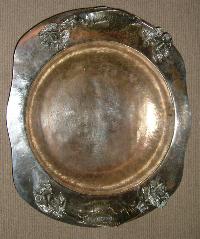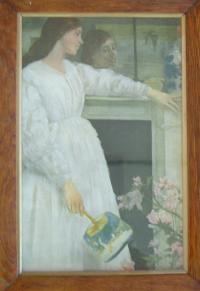Japonism


JAPONISTE
BOWL
Rare
silver plated bowl in the Japoniste taste, in hand raised
copper, with fish, sea-horse and seaweed handles, signed 'BACILLAR'
Height
0.140, Width 0.500, Depth 0.420
Price
£675.00 (J2)

WHISTLER
PRINT
Beautiful
framed 'Japoniste' print, in original oak frame with gilt
inner slip frame, 'Symphony in White, No.2: The Little White
Girl' by James McNeill Whistler
Height
0.460, Width 0.320
Price
£365.00 (J1)
Japonism (also in French Japonisme
and Japonaiserie) is the influence of Japanese art
on Western, primarily French, artists. The art that originated
from this influence is called japonesque.
While American intellectuals maintained that Edo prints were
a vulgar art form, unique to the period and distinct from
the refined, religious, national heritage of Japan known as
Yamato-e (pictures from the Yamato period, e.g. Zen masters
Sesshu and Shubun), ukiyo-e, Japanese wood-block prints, became
a source of inspiration for Art Nouveau, cubism and many European
impressionist painters in France.
History
During the Kaei era (1848 - 1854), many foreign merchant ships
came to Japan. Following the Meiji restoration in 1868, Japan
ended a long period of national isolation and became open
to imports from the West, including photography and printing
techniques and in turn, many Japanese ukiyo-e prints and other
artworks came to Europe and America and soon gained popularity.
Japonism started with the frenzy to collect Japanese art,
particularly print art (ukiyoe), of which the first samples
were to be seen in Paris. About 1856, the French artist Félix
Bracquemond first came across a copy of Hokusai's Manga sketchbooks
in a Paris studio. The frenzy for all things Japanese was
immediate. In 1871 Camille Saint-Saëns wrote a one-act
opera, La princesse jaune to a libretto by Louis Gallet, in
which a Dutch girl is jealous of her artist friend's fixation
on an ukiyoe woodblock print. French collectors, writers,
and art critics undertook many voyages to Japan in the 1870s
and 1880s, leading to the publication of articles about Japanese
aesthetics and the increased distribution of prints in Europe,
especially in France. Among them, the liberal economist Henri
Cernuschi the critic Theodore Duret (both in 1871 - 1872),
and the British collector William Anderson, who lived for
some years in Edo and taught medicine. (Anderson's collection
has been acquired by the British Museum.) Several Japanese
art dealers subsequently resided in Paris, such as Tadamasa
Hayashi and Jijima Hanjuro. The Paris Exposition Universelle
of 1878 presented many pieces of Japanese art.
Artists and movements
Japanese artists who had a great influence included Utamaro
and Hokusai. Curiously, while Japanese art was becoming popular
in Europe, at the same time, the bunmeikaika (Westernization)
led to a loss in prestige for the prints in Japan.
Artists who were influenced by Japanese art were van Gogh,
Monet, Manet, Degas, Renoir, James McNeill Whistler (Rose
and silver: La princesse du pays de porcelaine, 1863-64),
Camille Pissarro, Klimt, and many others. Whistler was very
instrumental in introducing England to Japanese art. Paris
was the acknowledged center of all things Japanese and Whistler
spent many years there collecting Japanese art. Several of
van Goghs's paintings imitate ukiyo-e in style and in motif.
For example, Le Père Tanguy, the portrait of the proprietor
of an art supply shop, shows six different ukiyo-e in the
background scene. He painted The Courtisan in 1887 after finding
an ukiyo-e by Kesai Eisen on the cover of the magazine Paris
Illustré in 1886. At this time, in Antwerp, he was
already collecting Japanese stamps. In terms of music, one
can say that Giacomo Puccini used Japonism, as he showed in
his famous Madama Butterfly. There were many characteristics
of Japanese art that influenced these artists. In the Japonisme
stage, they were more interested in the asymmetry and irregularity
of Japanese art. Japanese art consisted of off centered arrangements
with no perspective. light with no shadows and vibrant colors
on plane surfaces. These elements were in direct contrast
to Roman-Greco art and were embraced by 19th Century artists,
they freed the Western, artistic, mentality from academic
conventions.
Ukiyo-e, with their curved lines, patterned surfaces and contrasting
voids, and flatness of their picture-plane, also inspired
Art Nouveau. Some line and curve patterns became graphic clichés
that were later found in works of artists from all parts of
the world.These forms and flat blocks of color were the precursors
to abstract art in modernism.
|